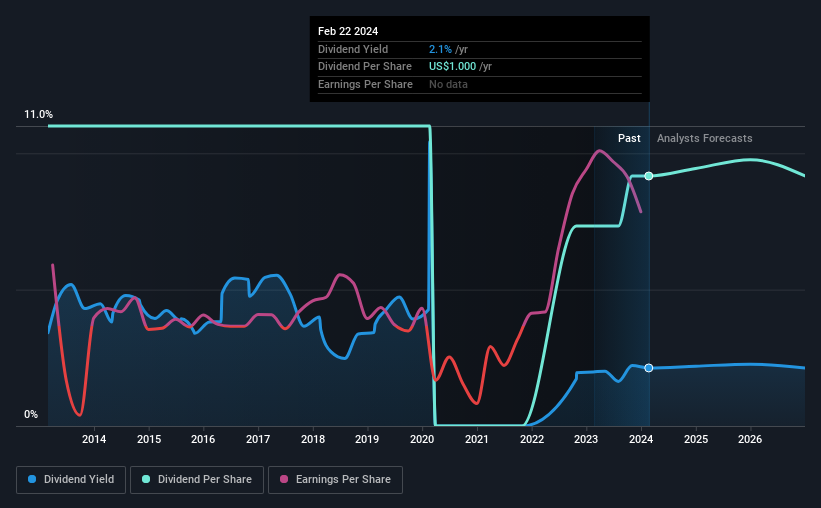Be Sure To Check Out PBF Energy Inc. (NYSE:PBF) Before It Goes Ex-Dividend
Some investors rely on dividends for growing their wealth, and if you're one of those dividend sleuths, you might be intrigued to know that PBF Energy Inc. (NYSE:PBF) is about to go ex-dividend in just 4 days. The ex-dividend date occurs one day before the record date which is the day on which shareholders need to be on the company's books in order to receive a dividend. It is important to be aware of the ex-dividend date because any trade on the stock needs to have been settled on or before the record date. Thus, you can purchase PBF Energy's shares before the 28th of February in order to receive the dividend, which the company will pay on the 14th of March.
The company's upcoming dividend is US$0.25 a share, following on from the last 12 months, when the company distributed a total of US$1.00 per share to shareholders. Based on the last year's worth of payments, PBF Energy stock has a trailing yield of around 2.1% on the current share price of US$46.99. If you buy this business for its dividend, you should have an idea of whether PBF Energy's dividend is reliable and sustainable. So we need to investigate whether PBF Energy can afford its dividend, and if the dividend could grow.
Check out our latest analysis for PBF Energy
Dividends are typically paid out of company income, so if a company pays out more than it earned, its dividend is usually at a higher risk of being cut. PBF Energy is paying out just 5.0% of its profit after tax, which is comfortably low and leaves plenty of breathing room in the case of adverse events. Yet cash flows are even more important than profits for assessing a dividend, so we need to see if the company generated enough cash to pay its distribution. It paid out 16% of its free cash flow as dividends last year, which is conservatively low.
It's positive to see that PBF Energy's dividend is covered by both profits and cash flow, since this is generally a sign that the dividend is sustainable, and a lower payout ratio usually suggests a greater margin of safety before the dividend gets cut.
Click here to see the company's payout ratio, plus analyst estimates of its future dividends.
Have Earnings And Dividends Been Growing?
Stocks in companies that generate sustainable earnings growth often make the best dividend prospects, as it is easier to lift the dividend when earnings are rising. If business enters a downturn and the dividend is cut, the company could see its value fall precipitously. It's encouraging to see PBF Energy has grown its earnings rapidly, up 74% a year for the past five years. PBF Energy looks like a real growth company, with earnings per share growing at a cracking pace and the company reinvesting most of its profits in the business.
The main way most investors will assess a company's dividend prospects is by checking the historical rate of dividend growth. PBF Energy's dividend payments per share have declined at 1.8% per year on average over the past 10 years, which is uninspiring.
The Bottom Line
Should investors buy PBF Energy for the upcoming dividend? PBF Energy has grown its earnings per share while simultaneously reinvesting in the business. Unfortunately it's cut the dividend at least once in the past 10 years, but the conservative payout ratio makes the current dividend look sustainable. PBF Energy looks solid on this analysis overall, and we'd definitely consider investigating it more closely.
In light of that, while PBF Energy has an appealing dividend, it's worth knowing the risks involved with this stock. To that end, you should learn about the 3 warning signs we've spotted with PBF Energy (including 2 which are a bit concerning).
If you're in the market for strong dividend payers, we recommend checking our selection of top dividend stocks.
Have feedback on this article? Concerned about the content? Get in touch with us directly. Alternatively, email editorial-team (at) simplywallst.com.
This article by Simply Wall St is general in nature. We provide commentary based on historical data and analyst forecasts only using an unbiased methodology and our articles are not intended to be financial advice. It does not constitute a recommendation to buy or sell any stock, and does not take account of your objectives, or your financial situation. We aim to bring you long-term focused analysis driven by fundamental data. Note that our analysis may not factor in the latest price-sensitive company announcements or qualitative material. Simply Wall St has no position in any stocks mentioned.

